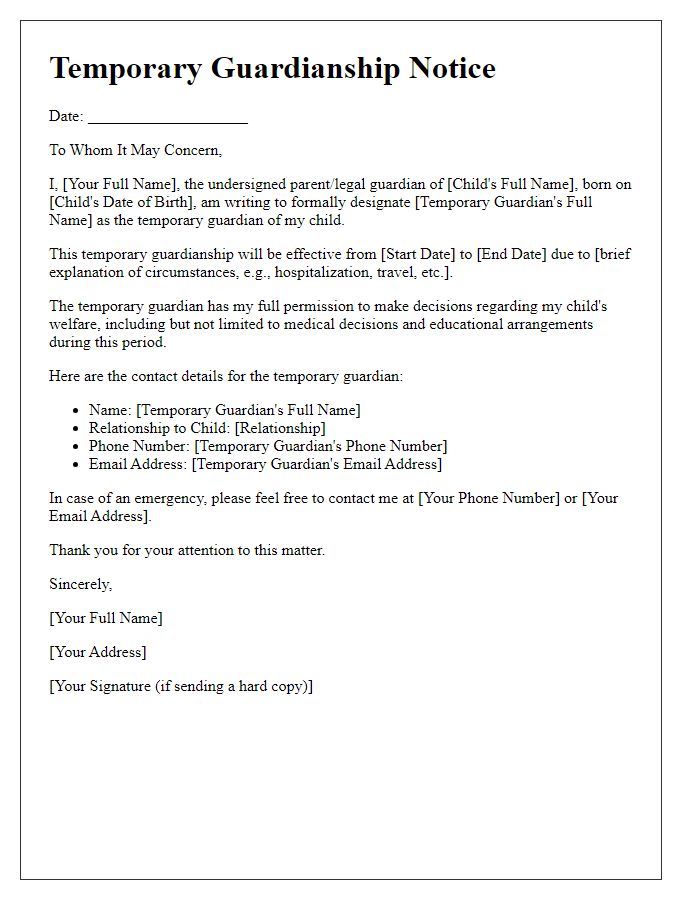When it comes to ensuring the well-being of our loved ones, having a temporary guardianship plan in place is essential. This proactive step not only provides peace of mind during uncertain times but also assures the security and care of children or dependents. In this article, we'll explore the intricacies of establishing temporary guardianship, including who can serve as a guardian and the legal considerations involved. So, if you're ready to learn how to safeguard your family, keep reading for valuable insights!

Guardian Information
A temporary guardianship arrangement can be critical in ensuring a child's welfare during unforeseen circumstances. The appointed guardian, often a trusted family member or friend, assumes responsibility for the child's daily care and decision-making. Important details include the guardian's full name, relationship to the child, contact information, and address. The duration of the guardianship, determined by specific events such as hospitalization or deployment, must be clearly outlined, ensuring clarity on the timeline for both parties involved. Legal documentation, such as notarized agreements, helps reinforce the validity of this arrangement. In addition, emergency contacts and any specific instructions regarding the child's medical needs, educational provisions, or other essential considerations should be included to provide comprehensive guidance for the guardian.
Child's Information
Temporary guardianship notifications require detailed information about the child involved. Include the child's full name, date of birth, and current residence address. Specify the names and contact information of both biological parents to establish the legal framework for guardianship. Outline the reasons for the temporary guardianship arrangement, such as family emergencies or parental absence. Provide the proposed guardian's full name, relationship to the child, and their relevant contact details. Clearly state the duration of the guardianship, including start and end dates, to ensure transparency. It's crucial to mention any specific instructions regarding the child's care, education, and medical needs to inform the guardian of their responsibilities fully.
Duration of Guardianship
A letter template for notifying temporary guardianship serves as an essential document that formalizes the appointment of a guardian for a specified duration. This notification typically outlines the beginning and end dates of the guardianship period, ensuring clarity and legality in custody arrangements for minors or dependents. It addresses the rights and responsibilities bestowed upon the temporary guardian, including decision-making authority concerning health care, education, and welfare. The duration of guardianship, clearly defined within the letter, becomes crucial to prevent misunderstandings and safeguard the best interests of the child, creating a structured framework for transitioning care during unexpected circumstances.
Specific Powers Granted
Temporary guardianship arrangements can establish a framework for specific powers granted to a designated caregiver. In these situations, the temporary guardian may receive authority to make decisions regarding the child's healthcare, including medical treatment and emergency care situations (involving hospitals or clinics). Educational decisions may also fall under the guardian's responsibilities, such as enrolling the child in school and attending parent-teacher meetings. Furthermore, the authority can extend to day-to-day care, allowing the guardian to manage the child's daily activities, supervision, and welfare while in their temporary custody. This structure is crucial for ensuring the child's well-being during the absence of the parents, providing clarity about the guardian's roles and responsibilities.
Legal Authorization Details
Temporary guardianship arrangements involve legal documentation that outlines the authority granted to a guardian for a specified duration. This arrangement often stems from circumstances such as parental incapacity or absence, necessitating the need for a responsible adult to care for a child. The legal authorization includes the names of involved parties, such as the child's primary guardians and the appointed temporary guardian, typically alongside contact information. Important dates signify the start and end of the guardianship period, often agreed upon in the document. Additionally, the specific powers granted to the guardian, which may include decisions related to education, healthcare, and general welfare, should be clearly detailed. This legal framework ensures transparency and accountability during the guardianship, aligning with local jurisdiction laws and regulations governing family law matters.
Letter Template For Notifying Temporary Guardianship Samples
Letter template of temporary guardianship notification for minor children.

Letter template of temporary guardianship announcement for family member care.

Letter template of temporary guardianship communication for educational needs.

Letter template of temporary guardianship disclosure for health care decisions.

Letter template of temporary guardianship information for school registrar.

Letter template of temporary guardianship statement for social service agencies.

Letter template of temporary guardianship alert for childcare providers.

Letter template of temporary guardianship notice for emergency contacts.






Comments